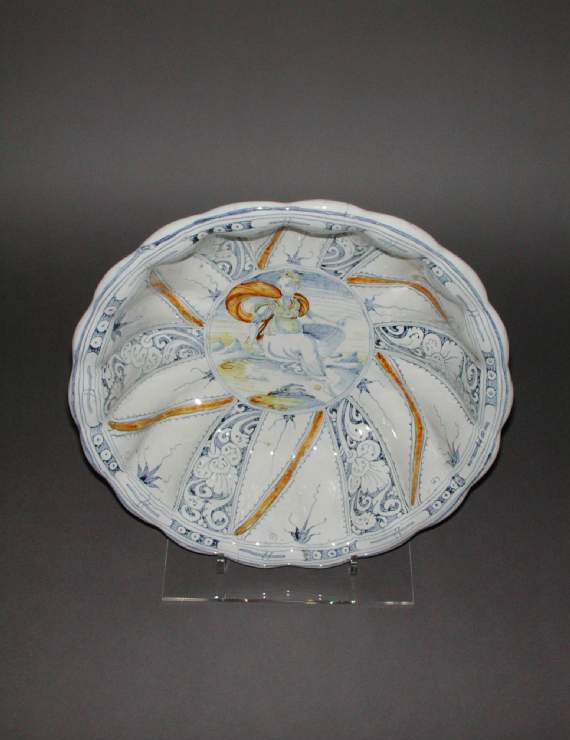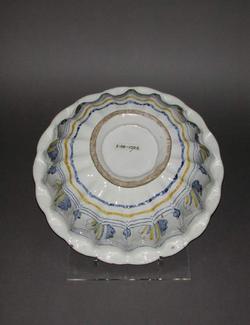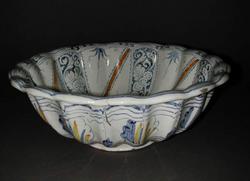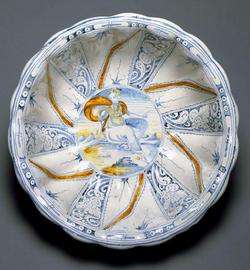Current Location: Gallery 27 (Glaisher)
Maker(s)
Workshop:
Bettisi, Leonardo di Antonio
Entities
-
Bowl
- deep bowl on low foot
- rinfrescatoio
Categories
Description
Maiolica deep bowl on a low foot, painted in blue, yellow, and orange, with a woman with billowing drapery sitting in a rocky landscape.
Earthenware, tin-glazed overall. Painted in dark blue, yellow, and orange. Shape 75. In the middle, within three narrow concentric circles, a woman with billowing drapery sits in a rocky landscape. Radiating from the medallion are six wide and six narrow panels, the former traversed by an orange diagonal stripe with a stylised plant on each side of it, the latter decorated with foliage reserved in a blue ground. On the rim there is a repeating border comprising elongated ovals alternating with groups of three beads, reserved in a blue ground between narrow bands. On the outside are blue and yellow split leaves between groups of horizontal blue bands, the lower group having a yellow band second from the bottom.
Notes
History note: Unknown before Dr J.W.L. Glaisher, FRS, Trinity College, Cambridge
Legal notes
Dr J.W.L. Glaisher Bequest
Measurements and weight
Diameter: 33.5 cm
Height: 12.2 cm
Acquisition and important dates
Method of acquisition: Bequeathed
(1928-12-07)
by
Glaisher, J. W. L., Dr
Dating
16th Century, Late
Circa
1570
CE
-
1590
CE
Note
Faenza white miaiolica (bianchi di Faenza) was being made by the 1540s and, during the second half of the sixteenth and the early seventeenth century, gained acclaim throughout Europe. Its attraction lay primarily in the high quality and whiteness of its glaze. When painted decoration was added, it was executed mainly in blue, yellow, and orange, sometimes with green, and rarely with a little red. This deep fluted bowl illustrates two of the most characteristic types of decoration on Faenza white ware. Its central roundel is painted in compendiario (sketchy or summary) style and its sides with radiating panels a ricamo (resembling embroidery). Bowls of this form were made from at least the early 1560s. An example with different decoration in the Hermitage at St Petersburg is inscribed 'in Faienca'1563'. Bowls and basins (bacini or catini) are mentioned in sixteenth-century inventories of Fenza services, and it therefore seems likely that they were used with a ewer for hand-washing or perhaps for rinsing fruit at table. A water cistern for cooling bottles was usually described as a rinfrescatoio.
On the basis of initialled or signed pieces, bowls comparable to this one have been attributed to the workshop of Virgiliotto Calamelli (d. c. 1570) and to his successor Leonardo di Antonio Bettisi, alias 'Don Pino' , who leased the workshop form Virgiliotto's widow in 1570. During the latter part of his life, Leonardo was assisted by his son, Antonio, who took over the workshop on his father's death, probably before 1589. Two documents of 1581 indicate that the two were sometimes referred to jointly as the 'Don Pini'. The Fitzwilliam's bowl is attributed to Leonardo on the basis of two others signed 'DOPI' and 'DO.PI', respectively in the Silesian Museum Opava, and an Italian private collection. The latter cannot have been made before 1571 because it bears the arms of Girolamo di Antonio Michelozzi and Caterina di Braccio Alberti, who were married in that year. A fragment of a bowl centre signed 'DO.PI', and two comparable unsigned bowls are in the International Ceramic Museum at Faenza (nos. 7429, 9832 and 10607).
School or Style
Renaissance
People, subjects and objects depicted
Components of the work
Decoration
composed of
high-temperature colours
( dark blue, yellow, and orange)
Materials used in production
Tin-glaze
Earthenware
Techniques used in production
Moulding
: Earthenware, moulded, tin-glazed overall, and painted in dark blue, yellow, and orange.
Tin-glazing
References and bibliographic entries
Related exhibitions
Identification numbers
Accession number: C.2188-1928
Primary reference Number: 73180
Stable URI
Audit data
Created: Saturday 6 August 2011
Updated: Tuesday 17 December 2024
Last processed: Tuesday 16 September 2025
Associated departments & institutions
Owner or interested party:
The Fitzwilliam Museum
Associated department:
Applied Arts







